 General description The COR-TENŽ steel grades comprise a range of high strength, low alloy, structural steels in which the alloy content has been formulated to provide a protective oxide layer on the steel under normal atmospheric conditions. COR-TENŽ steel has enhanced atmospheric corrosion resistance when compared with ordinary carbon steel in order to give acceptable service in the unpainted condition and superior performance when painted. Typical applications of COR-TENŽ brand steel include transport containers, freight and passenger railway cars, electrification and light stands, transmission towers, a wide range of architectural and structural applications in the building and construction industry, highway guard rails and surface structures related to mining. Weathering characteristics To achieve the benefits of the enhanced atmospheric corrosion resistance of bare COR-TENŽ steel, it is necessary that proper design, detailing, fabrication and erection procedures are observed. Care should be taken to avoid moisture entrapment. Ventilation should be sufficient to allow proper wet/dry cycles. When COR-TENŽ brand is exposed under the above-mentioned conditions a homogeneous patina consisting of corrosion product forms. After an initial exposure period of two to three years, the patina stabilises, drastically reducing the rate of further corrosion. The presence of sulphur in the atmosphere contributes to the rapid formation of a stable film. The patina is a dense, tightly adherent, thin oxide layer, which contains alloying elements in the same ratio as is found in the base metal. Insoluble sulphates of the alloying elements, such as copper, chromium and nickel tend to block the pores, resulting in a dense protective layer. Different rates of corrosion are experienced in different atmospheres. As part of an international COR-TENŽ corrosion data collection programme, Iscor established test sites in typical rural, marine and industrial environments. Sixteen years of data have been collected and the results are reflected in the accompanying graphs. 'Penetration' pertains to the reduction in thickness of the samples, one side only, resulting from corrosion. Under continuous wet or buried conditions the corrosion rate of COR-TENŽ may be the same as carbon steel, as the patina does not stabilise and is therefore not recommended. In marine environments stable oxide films may form on the steel, provided chlorides are washed off regularly. Normally the use of unpainted COR-TENŽ is not recommended for applications subjected to salt spray. see more |